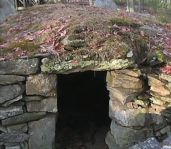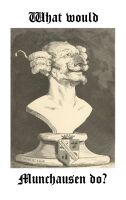|
by Charles L. Hogue  A guide to diverse marvels close at hand
A guide to diverse marvels close at hand
It seems that one of Nature's unspoken rules is that the smaller things get, the stranger they become. Quantum mechanics, for example, which describes the activities of particles at sub-atomic levels, challenges our understanding of the universe as our senses receive it: even our knowledge of the trajectory of a sub-atomic particle, for example, means that its position cannot be known, and light, depending on how one observes it, behaves as either a particle or a wave. The universe as described by quantum mechanics is a much stranger place than the one postulated by LaPlace and Newton. Similarly, in the field of biology, the world revealed by the microscope is much stranger than anything that we could have derived from observations of those organisms visible to the naked eye. This denizens of this realm include various and marvelous creatures: species which defy classification as either plant or animal; genera which contain within them certain species which reproduce sexually, while their close relatives procreate by division; creatures which spend part of their lives as independent single celled units, and other parts of their lives as part of a multicelled organism, with certain cells acting as the stalk on which others form a fruiting body. Our understanding of classification, sex, and the very distinction between single celled and multicellular organisms is challenged by this wonderful microscopic world which lies all around us. Though man is still the measure of all things (by virtue of having invented the yardsticks by which we observe the universe), the cosmos were not made in our image, nor we in theirs, and though the universe is a wonderful place, it is also a strange and disconcerting one. As we look at organisms which are somewhat closer in size to our own, they lose some, but not all, of that strangeness which the quantum and microscopic worlds contain, and Charles L. Hogue's Insects of the Los Angeles Basin makes this strangeness accessible to us all. Hogue was Curator of Entomology for the Natural History Museum for 30 years, and this guide has its origin in part in those questions asked by Angelenos during his tenure there. This guide was another of those books which our West Coast friends gave to my wife Fayaway and myself, in an effort to convince us to move out to California, and we have come to know many of the strange and wonderful species described in these pages: the beautiful butterflies which visit our gardens, the speedy dragonflies and the mosquitoes on which they feed, the multiform beetles which live beneath our feet, our houses, and our lawns. It was in these pages I first took note of the California Sister, a butterfly species which lives among the oaks of the Santa Monicas; I ran to this book to discover the name of that strange beast that had crawled into our bathtub during the night, and had caused my wife, who is not easily frightened, to scream out (it was the Jerusalem cricket, a creature whose virtues do not include beauty or grace); I used this book to identify the strange beetle larva which was content only when travelling on its back. These and many other creatures have become better known to me through the pages of this book. The guide is very easy to use, once one knows the difference between a cricket and grasshopper, a cockroach and beetle, and the book will help the reader learn that. It is full of drawings and photographs, many in beautiful full-color, of most of the species described, as well as information about their habits, ecology, and life history. The author is also candid about what is not known about certain species, such as the larval stages, their feeding habits, or their modes of reproduction. Nothing is known of the early life of the California Glowworm, for example. Each description contains a list of its sources as well. These excellent descriptions are preceded by an introduction to basic entomology: there are sections on insect body structure and function, growth and development, and classification, and a chapter on the Los Angeles Basin environment and ecology. Another fine feature is the full color map, computer-generated from Landsat photographs, of the region covered by this book. There is also a very good glossary, a general bibliography and resource list, and an index. One need do little more than walk out the door with this book in hand to find it immediately useful: it is full of information for those interested in the insect life around us. Indeed, I have found that whenever I go out to the garden to read some other work, it is wise to bring this book as well, since inevitably I will feel compelled to go back into the house to find the answer to some question about some creature or other whose path I happen to cross. The value of this book to amateur entomologists is inestimable: it will not only drive the curious out into the gardens, forest, and hills to seek those creatures listed here, but provide information to those whose first instinct is to kill any such creature they might find in their domicile, and help them learn that the natural world is not as frightening as it might at first seem, even though it might never lose its strangeness. Recommended to anyone interested in learning more about those insects and arachnids with whom we share the Los Angeles Basin, and who are essential parts of the local ecology, strange and frightening though they might seem at first glance. |

